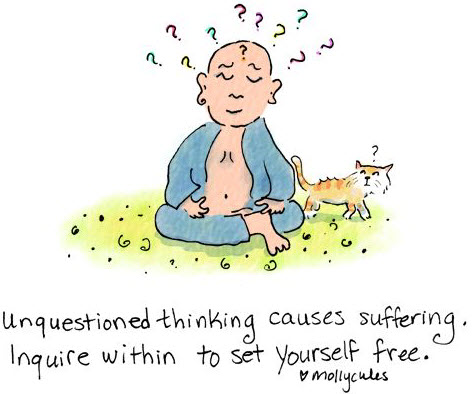“The thought he wants to think, that, he thinks.”

“The thought he does not want to think, that, he does not think.”
Buddhist Sutra on the Removal of Distracting Thoughts
Introduction
Modern psychology estimates that we have 40 to 60 thousand thoughts a day, and most of them are repetitious, useless – and often, unhappy.
1- The first level – thought substitution
It stands to reason that the thoughts you most want to remove would be negative: fears, anxieties, anger, lust, revenge, pride.
And therefore the easiest way to counteract them is to reflect on the opposite. What is the positive counterpart to your affliction?
Just a few examples then:
If you hate someone, then reflect on love. Think kind and loving thoughts about them.
If you lust after someone, or something, then reflect on their bad points, or their ugliness.
If you are just agitated and restless, then reflect on peace and harmony. Visualise yourself in a calm environment, a mental “happy place”.
On the deeper level, feel the counteracting emotion completely. Simply drench yourself with it. Imagine it as an energy, a light, a waterfall – anything that works best for you. This might be hard initially, but that’s normal.
Get some exercise, put on some music and relax, or take a break from whatever you have to do.
2- The second level – Reflect on the outcome
The next level goes a touch deeper. Look past the thoughts themselves, and see what they are costing you.
Perhaps you are distracted at work by hatred for your colleague.
Then reflect on it – instead of trying to fight it, turn around and face it. What would happen if you didn’t stop, if you indulged in your thoughts?
Maybe you would get fired.
Simply realise how much misery it is already causing you, and how much more it can cause you if you kept on doing it. Feel it. Feel the hatred or the fear totally.
3- The third level – Letting the thoughts go (grounding)
This level is about simply letting your thoughts slide by without attaching to them. Thoughts are just thoughts. You are not your thoughts. You don’t have to believe them; you don’t have to fight them; you don’t have to cling to them. They are just thoughts, and they only have power if you give them power. i.e. thinking more thoughts.
4- The fourth level – Feel the emotional source of the thoughts
The first thing we have to realise is that thoughts always have a source – our emotions. The two are inextricably linked; they feed each other in one giant cycle.
What is causing your thoughts? If you think a lot of cruelty and hatred, then the emotion of anger is right there underneath it.
Emotions are your body’s reaction to your mind. At this level, one of the most powerful, we shall simply cut to the root of the issue.
How do we deal with our emotions?
The simplest way – and yet no one ever says it!
Simply feel it.
Bring it to the surface, find the emotion, and feel it.
Feel it, simply as an emotion, a sensation. Emotions and feelings are not wrong or right, good or bad. They simply are. They are just emotions. Even the most murderous rage is not wrong – it is only bad if you act on it.
Just embrace it, let it be there. Don’t push it away or judge it. Relax into it, loosen any tightened muscles, and remember to keep breathing normally. Ride the wave, and let it pass. Don’t think about it – thinking about it will make you want to act on it.
Often times, these emotions run deep, and can take a lot of work to uncover and heal with your conscious embrace. But the journey is worth it – it is one of the best ways, perhaps the only way, of dealing with your emotions.
Heal the emotions, and the thoughts they cause will disappear.
5- The fifth level – Force down the bad thoughts
This level is the hardest, and draws upon the techniques of modern psychology. It is hard and painful, and should be reserved for the most extreme cases. At this level, simply force yourself to stop thinking about it.
Forceful Phrase. Any time you catch yourself with a thought you don’t want, interrupt it with a prepared mantra. Make it a forceful phrase, one that works and feels right for you. “Stop!” “Enough!” “No more!”
The Rubber Band. Wear a rubber band around your wrist. And every time you catch yourself with a negative thought, snap the rubber band. It hurts a little bit, and you are telling your system that such thoughts hurt
Filling in the gap. An important thing to note is that once you stop your thoughts, a space is created. If you don’t fill that gap in, the distracting thoughts will return to fill it. Yes, Thank you,
